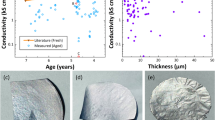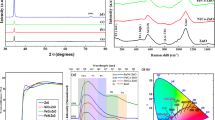Abstract
It is known that TiO2/SiO2 nanocomposite thin films have several properties improved when compared with the TiO2 or SiO2 pure thin films. In this work, a systematic study of xTiO2/(100 − x)SiO2 films (x = 0, 20, 40, 60, 80, and 100%) with different numbers of layers (1–5), i.e., different thicknesses, prepared by sol–gel process using dip-coating deposition was made. The films were thermally treated and characterized by UV–Vis spectroscopy and ellipsometry to evaluate the optical properties and thicknesses. Transmittance of the films were discussed by means of the interference fringes and refractive index modulation as a TiO2/SiO2 ratio function. The values of refractive index, extinction coefficient, and band gap obtained from ellipsometric analyses were related to the changes in UV–Vis spectra. The construction of the xTiO2/(100 − x)SiO2 structural models for a precise ellipsometric analyses were based on a comprehension of theoretical models. The glass substrate and SiO2 film were modeled by Cauchy; TiO2 film by Tauc–Lorentz and TiO2/SiO2 by Bruggeman theories. A graded refractive index function was necessary to fit the thicker films with low mean square error (MSE). Moreover, the refractive index values permitted the calculation of total porosity of the films, using Lorentz–Lorentz equation. Atomic force microcopy images showed clearly the effect of SiO2 addition on TiO2, reducing the particle size and root mean square roughness (from 1.4 to 0.3 nm). The lowest roughness of TiO2/SiO2 films was correlated with their enhanced hardness. All TiO2/SiO2 films showed a persistent super hydrophilicity that makes them suitable for applications in environmental and energy fields.

A systematic study of xTiO2/(100 − x)SiO2 films (x = 0, 20, 40, 60, 80, and 100%) with different numbers of layers (1–5) prepared by sol–gel process using dip-coating deposition was made. The effect of mixing SiO2 with TiO2, reducing the particle size and RMS roughness (from 1.4 to 0.3 nm) was correlated with their enhanced hardness and super hydrophilicity that makes them suitable for applications in environmental and energy fields
Highlights
-
Systematic study of TiO2/SiO2 thin films as a function of thickness and composition.
-
Structure, morphology, mechanical, and optical properties understandings.
-
Cauchy, Tauc–Lorentz, and Bruggeman models were used for interpreting optical properties.
-
The films have presented superhydrophilic surfaces.
-
Those properties make the films promising for applications in environmental and energy fields.












Similar content being viewed by others
References
Miao L, Su LF, Tanemura S, Fisher CAJ, Zhao LL, Liang Q, Xu G (2013) Cost-effective nanoporous SiO2–TiO2 coatings on glass substrates with antireflective and self-cleaning properties. Appl Energy 112:1198–1205
Ye L, Zhang Y, Zhang X, Hu T, Ji R, Ding B, Jiang B (2013) Sol–gel preparation of SiO2/TiO2/SiO2–TiO2 broadband antireflective coating for solar cell cover glass. Sol Energy Mater Sol Cells 111:160–164
Jesus MAML, Neto JTS, Timò G, Paiva PRP, Dantas MSS, Ferreira AM (2015) Superhydrophilic self-cleaning surfaces based on TiO2 and TiO2/SiO2 composite films for photovoltaic module cover glass. Appl Adhes Sci 3:5
Faustini M, Nicole L, Boissière Cd, Innocenzi P, Cm Sanchez, Grosso D (2010) Hydrophobic, Antireflective, self-cleaning, and antifogging sol−gel coatings: an example of multifunctional nanostructured materials for photovoltaic cells. Chem Mater 22:4406–4413
Karbay IHC, Budakoglu R, Zayim EO (2015) Improvement of mechanical properties of glass substrates. Appl Surf Sci 357:1890–1894
Kermadi S, Agoudjil N, Sali S, Boumaour M, Bourgeois S, Marco de Lucas MC (2014) Sol-gel synthesis of xTiO2(100−x)SiO2 nanocomposite thin films: structure, optical and antireflection properties. Thin Solid Films 564:170–178
Roldán MV, Castro Y, Pellegri N, Durán A (2015) Enhanced photocatalytic activity of mesoporous SiO2/TiO2 sol–gel coatings doped with Ag nanoparticles. J Sol-Gel Sci Technol 76:180–194
Šuligoj A, Štangar UL, Ristić A, Mazaj M, Verhovšek D, Tušar NN (2016) TiO2–SiO2 films from organic-free colloidal TiO2 anatase nanoparticles as photocatalyst for removal of volatile organic compounds from indoor air. Applied. Catal B: Environ 184:119–131
Viana MM, Mohallem TDS, Mohallem NDS (2006) Nanocrystalline titanium dioxide thin films prepared by sol-gel process. Braz J Phys 36:1081–1083
Iler RK (1979) The chemistry of silica: solubility, polymerization, colloid and surface properties, and biochemistry. John Wiley & Sons, New York
Rowlette PC, Wolden CA (2009) Digital Control of SiO2−TiO2 Mixed-Metal Oxides by Pulsed PECVD. ACS Appl Mater Interfaces 1:2586–2591
Mazur M et al. (2016) Functional photocatalytically active and scratch resistant antireflective coating based on TiO2 and SiO2. Appl Surf Sci 380:165–171
Tricoli A, Righettoni M, Pratsinis SE (2009) Anti-fogging nanofibrous SiO2 and nanostructured SiO2−TiO2 films made by rapid flame deposition and in situ annealing. Langmuir 25:12578–12584
Louis B, Krins N, Faustini M, Grosso D (2011) Understanding crystallization of anatase into binary SiO2/TiO2 sol−gel optical thin films: an in situ thermal ellipsometry analysis. J Phys Chem C 115:3115–3122
Kermadi S et al. (2015) Microstructure and optical dispersion characterization of nanocomposite sol-gel TiO2-SiO2 thin films with different compositions. Spectrochim Acta A Mol Biomol Spectrosc 145:145–154
Mohallem NDS, Aegerter MA (1988) Multilayer SiO2 and TiO2 coatings on glasses by the sol-gel process. J Non-Cryst Solids 100:526–530
ISO 14577-1:2002 and ISO 14577-4 (2016) Metalic Materials-Instrumented indentation test forhardness and materials paramiters, International Organization for Standartization
Fischer-Cripps AC (2004) Nanoindentation, 2 edn. Springer Science, New York
Oliver WC, Pharr GM (2004) Measurement of hardness and elastic modulus by instrumented indentation: Advances in understanding and refinements to methodology. J Mater Res 19:3–20
Farhang Ghoje Biglu Y, Taheri-Nassaj E (2013) Investigation of phase separation of nano-crystalline anatase from TiO2/SiO2 thin film. Ceram Int 39:2511–2518
Zhang WF, He YL, Zhang MS, Yin Z, Chen Q (2000) Raman scattering study on anatase TiO2 nanocrystals. J Phys D Appl Phys 33:912–916
Yazıcı M, Çomaklı O, Yetim T, Yetim AF, Çelik A (2016) Effect of sol aging time on the wear properties of TiO2–SiO2 composite films prepared by a sol–gel method. Tribology Int 104:175–182
Fujiwara H (2007) Spectroscopic ellipsometry principles and applications John Wiley & Sons Ltd, Chichester
Tauc J, Grigorovic R, Vancu A (1966) Optical properties and electronic structure of amorphous germanium. Phys Status Solidi 15:627–637
Sreemany M, Sen S (2007) Influence of calcination ambient and film thickness on the optical and structural properties of sol–gel TiO2 thin films. Mater Res Bull 42:177–189
Wang B-L, Hu L-L (2005) Effect of water content in sol on optical properties of hybrid sol–gel derived TiO2/SiO2/ormosil film. Mater Chem Phys 89:417–422
Rahmani E, Ahmadpour A, Zebarjad M (2011) Enhancing the photocatalytic activity of TiO2 nanocrystalline thin film by doping with SiO2. Chem Eng J 174:709–713
Satoh N, Nakashima T, Kamikura K, Yamamoto K (2008) Quantum size effect in TiO2 nanoparticles prepared by finely controlled metal assembly on dendrimer templates. Nat Nanotechnol 3:106–111
Eufinger K, Poelman D, Poelman H, Gryse RD, Marin GB (2008) TiO2 thin films for photocatalytic applications. Thin Solid Films Process Appl. 189–227
Maghami MR, Hizam H, Gomes C, Radzi MA, Rezadad MI, Hajighorbani S (2016) Power loss due to soiling on solar panel: A review. Renew Sustain Energy Rev 59:1307–1316
Midtdal K, Jelle BP (2013) Self-cleaning glazing products: A state-of-the-art review and future research pathways. Sol Energy Mater Sol Cells 109:126–141
Swanepoel R (1983) Determination of the thickness and optical constants of amorphous silicon. J Phys E 16:1214–1222
Houmard M, Riassetto D, Roussel F, Bourgeois A, Berthomé G, Joud JC, Langlet M (2008) Enhanced persistence of natural super-hydrophilicity in TiO2–SiO2 composite thin films deposited via a sol–gel route. Surf Sci 602:3364–3374
Liu YY, Qian LQ, Guo C, Jia X, Wang JW, Tang WH (2009) Natural superhydrophilic TiO2/SiO2 composite thin films deposited by radio frequency magnetron sputtering. J Alloy Compd 479:532–535
Guan K (2005) Relationship between photocatalytic activity, hydrophilicity and self-cleaning effect of TiO2/SiO2 films. Surf Coat Technol 191:155–160
Acknowledgements
We would like to thank UFMG-Microscopy Center for the images and FAPEMIG, CNPq, and CAPES for financial support
Author information
Authors and Affiliations
Corresponding author
Ethics declarations
Conflict of interest
The authors declare that they have no conflict of interest.
Electronic supplementary material
Rights and permissions
About this article
Cite this article
Lopes de Jesus, M.A.M., de Magalhães Gomes, G.H., Ferlauto, A.S. et al. A systematic study of multifunctional xTiO2/(100 − x)SiO2 thin films prepared by sol–gel process. J Sol-Gel Sci Technol 89, 380–391 (2019). https://doi.org/10.1007/s10971-018-4867-8
Received:
Accepted:
Published:
Issue Date:
DOI: https://doi.org/10.1007/s10971-018-4867-8




